Overview of American destroyers in ww1:
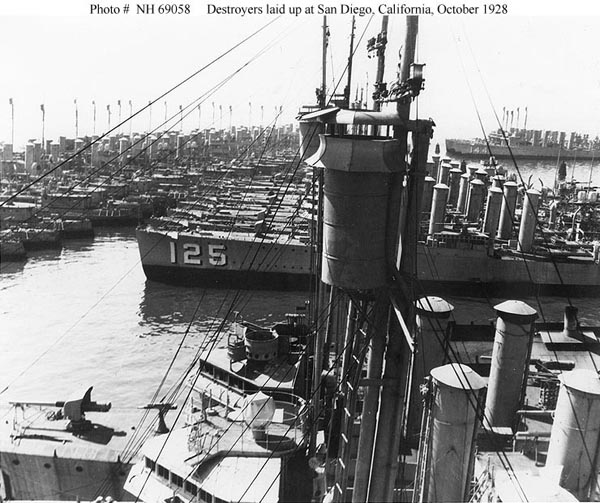
Mothballed Flushdeckers at San Diego in 1928 – USN Archives
The United States built more destroyers than any other nation on earth during the first world war. But when they started in 1914, they only had 50 ships, whereas the Royal Navy had 300 already. This is of course the reflection of the formidable industrial capability of the new world, woke up to its full wartime potential in 1917 and again 24 years after.
Most of this production was attributed to the famous four piper, flush-deckers destroyers of 1918-1921. These were designed with simplifications at any level (like the flush deck hull) but in armament were to the level of the Russian Novik.
What’s more, many survived the interwar (The others were mothballed and then scrapped in the 1930s) to fight another war, some under British colors and lend-lease, chasing U-Boats in the atlantic, taking part of the “most daring raid of all” (St Nazaire), or Japanese submarines in the Pacific, being converted in many roles like assault ships.
But it all started with a famous name, USS Farragut (not called DD1 by the way). And like any other nations, the ships was a 1899 prototype of “torpedo-boat killer”. Spain in fact already had destroyers when at war with the USA previously.
It went on with a serie of small classes of two-three ships (up to five) ordered by yard in 1900-1906. The real change appeared with the USS Smith (1909) a prototype that was like a replacement for the light scout cruisers the fleet lacked sorely at the time.
She was followed by homogeneous series of “four-stackers”, the Paulding, Monaghan, Cassin, O’Brien classes before the war, which all were classic in design, with a forecastle. And then came the wartime design, the Caldwell class in 1917, a prototype class, like a preserie for the flush-deckers, and of course the mass-produced Wickes and Clemson that followed.
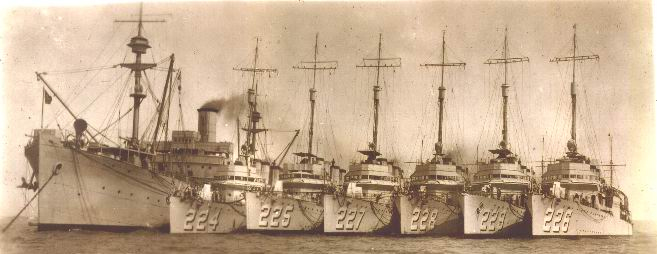
US WW1 Destroyers
Bainbridge | Truxtun | Smith | Paulding | Cassin | O'Brien | Tucker | Sampson | Caldwell | Wickes | ClemsonUSN destroyers saw active service in the Atlantic, their only likely theater of operation, against U-boats. They were not really efficient in this role.
Although fast enough to catch these, their Y-gun (installed on the Caldwell first) was their only efficient weapon in 1917 the Hydrophones was just being tested, and ASW grenades were not the norm yet.
In fact when studying U-boat losses during the great war (178), in appaeared that 58, so the majority of cases, hit mines, while 30 were destroyed by depth charges, 20 by gunfire and 20 by other submarines’s torpedoes, 19 by ramming, and 19 for unknown causes and 7 by accident.
Since naval aviation was just beginning, and despite the great number of planes involved see the Felixtowe saga for example, only two were lost because of air attacks, more possibly by blimps, albeit with small bombs causing little or no damage. Minefields, barrages, Q-ships and cryptanalysis were also quite efficient.
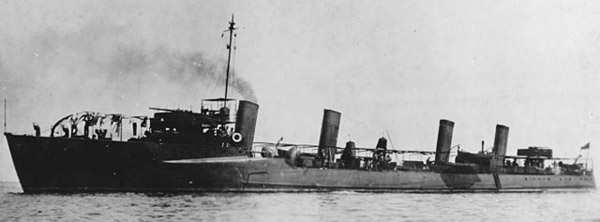
USS Chaucey, DD-3
Statistics wise, for ships before the “flush deckers”, all were broken up in the 1930s (1934-36) but the Smith class (1919), and only the USS Jacobs Jones DD-61 was sunk on 6 December 1917 by U 53 off the Scillies islands. The Caldwell were given to the Royal Navy in 1940 (Lend Lease) and survived. Of the 111 Wickes class in service, 9 were sunk in battle, 5 were sunk as targets, 7 others sunk or destroyed in other ways and 90 scrapped; For the Clemson, on 156 completed, 20 were lost in action or for other reasons.
As a general note, like other global posts like this one, this is also a preview for future posts, one on each of these destroyers the next years. But it’s a good overview of the matter already. There is also an unbalance between numerous small classes of a few ships each compared to very large classes like the ones of the late Clemson/Wickes that are more susceptible of a dedicated post right away.
Prewar American destroyers
Prewar to 1917 US destroyers were not very heavily modified during the conflict but nevertheless their role changed radically, from fleet surface escort to ASW patrols. The pre-1917 US destroyer designs were tailored with one duty only in mind:
Protect the battleline against torpedo attack by opposing destroyers or TBs while attacking opposing battleships was a secondary role, US destroyers carried a very heavy torpedo batteries by world’s fleets standards.
The great controversy of pre-1917 destroyer design was centered around greater size, for seakeeping or constraint it at the contrary to offer less target area to the enemy.
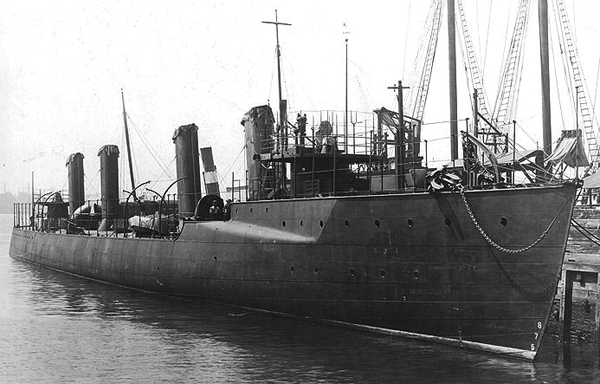
USS barry (DD-2), second American destroyer
The General Board ruled in favour of the former view, adding that in the context of a shortage of cruisers, destroyers would have to function also also as scouts. Seeing the confluct developed from home, the admiratly realized soon enough, as early as 1916 that destroyers could play a great role against submarines, the General Board requiring that bows be strengthened for ramming (which was one of the most common and effective tactic during WW1, see the statistics).
But the admiralty also realized its lack of preparedness, he having no depth charge and no submarine detector. But it did not altered plans to built more destroyers to perform ASW duties anyway.
They were not quite adaptated to the role, but as a production measure no alternative design was planned as the Royal Navy had to introduced improvized sloops and P-boats. The typical prewar destroyer characteristics like their high speed, went far beyond that was what required for U-boat warfare.
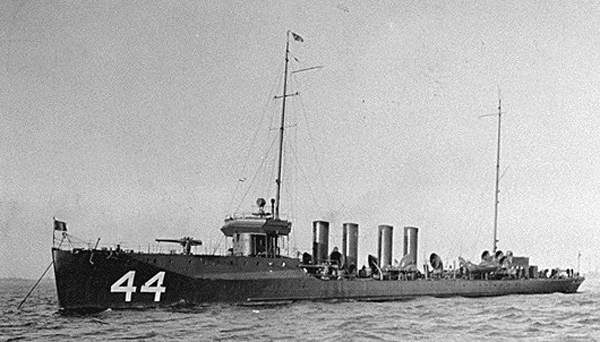
USS Cummings, DD-44 in 1916 in her peacetime livery, dark blue grey and large identification number
In 1917, a special ASW board proposed the construction of special mass-production destroyers restricted to 26kts that woould have been genuine WW1 ASW escort ships. But they were never authorized in the end, because major changes in design planned would have caused delays by too long.
Instead about 300 fleet destroyers of the Wickes and Clemson classes were used for this role. When spotting the torpedo trails when firing, fast ships could run back down the torpedo tracks while dropping patterns of depth charges around the spot.
The development of Y-guns that could fire depth charges to each side of a ship and supplement the usual stern racks was also a great addition; the Caldwell being the first to inaugurate the system.
ASW requirements traduced into wartime modifications, with depth-charge track aft despite top weight and Y-guns aft, sometimes in place of one AA gun. Hydrophones were aso adopted, fitted in ‘blisters’ on either side of the bow, and their receiving beam turned by a system of electrical compensators similar in principle to that to be found in a modern scanning sonar system…
In all cases, the US Navy quickly learned ASW warfare during these two years of naval fight in the Atlantic, with relatively few losses (Most occurred during WW2, among survivor flush-deckers).
USS Farragut: The one that started it all
The first American destroyer. This modest-sized ship was developed as a topedo-boat hunter with a powerful artillery. She was a fast ship, which served as a prototype for the following units, was reclassified as a coastal torpedo boat in 1918, and later broken up.
The ships was named after David Farragut, flag officer of the US Navy during the American Civil War, first rear admiral, vice admiral, and admiral in the US Navy.

Author’s illustration of the USS Farragut
Specifications
Displacement: 280t
Dimensions: 65,22 x 6,30 x 1,83m ()
Propulsion: 3 Thornycroft boilers, 2 propellers, 5870 hp, top speed 30 knots.
Crew: 66
Armament: 4 x 76 mm guns (3 in), 2 TLT of 457 mm (18 in).
Bainbridge class DD1-DD5 (1900)

The Bainbridge class was the first major series of US Navy destroyers. She succeeded to four “prototypes”, USS Farragut (1898), Stringham (1899), Goldsborough (1899) and Bailey (1899). The latter had more to do with high-sea destroyers, having in particular a complete bridge and a front part in “totue back” characteristic closely derived from torpedo boats. They experienced various problems and were logically reclassified as torpedo boats. The USS bainbridge, on the other hand, was a very clear step forward, with its much larger dimensions, its forecastle with a flat deck, and its more stability and autonomy. On the other hand, his armament changed little, with only two torpedo tubes. their role rested essentially on their light artillery destroyers. The initial bainbridge class included USS Bainbridge, Barry, Chauncey, Dale and Decatur. The two Hopkins who followed however returned to a hull with a low turtle back forward deck. Similar to the Bainbridge were the three Paul Jones Paul Jones, Perry, Preble) and the USS Stewart, launched in 1901-02. All participated in the great war.
The Hopkin DD6-DD7 (1902) was a sub-class, authorized under the act of 4. 5. 1898, which differred from the Bainbridge in having a forward turtleback and 3 in/50 guns in twin mounts, like two twin 18 in TTs mountings, after a first period with single mountings. Both (Hopkins and Hull) were built at Halan & Hollingsworth, served in WW1 and were broken up in 1920 and 1921. The Lawrence class DD8-DD9 (1900) was another sub-class, also with a turtle back deck forward, and four funnels in one group with two single TTs aft and far aft, two 3in/25 and five 6-pdr, but they were apparently the less succesful of the serie. The Lawrence and Macdonough were comissionned in 1903 were sold in 1920. The Paul Jones class DD10-DD12 (1901) was another sub-class from Union iron Works, three ships, Paul Jones, Perry and Preble, which were also fast with four Thornycroft boilers mated to two shafts VTE and 8000 ihp, reaching 29 knots on trials. Later their two single TTs were replaced by a single twin mount. All three were sold in 1920. The single USS Stewart DD13 (1902) built in Gas Engine & Power and CL seabury was the fastest of the “400 tonners”, reaching 29.7 knots for a design speed of 29 on trials.

Author’s digital HD illustration of the Bainbridge, with hull

Author’s illustration of the USS bainbridge
Specifications
Displacement: 420t
Dimensions: 76 x 7,2m x 2m
Propulsion: 4 Thornycroft boilers, 8000 hp. and 29 knots max.
Crew: 73
Armament: 2 x 3in (76 mm) guns, 5 x 6-pdr (75 mm) guns, 2 TTs 18in (457 mm).

USS decatur, DD-5
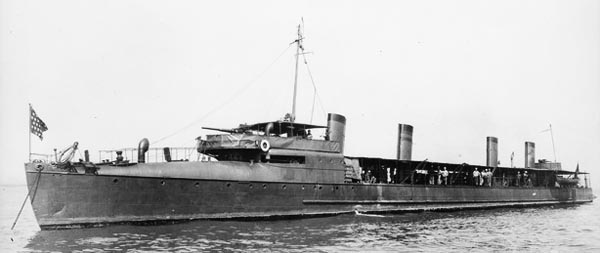
USS Hopkins, DD-6
Truxton class DD14-DD16 (1902)
These destroyers derived from the Bainbridge class by in their low front deck in “turtle back”. Larger at 433 tons, their funnels were also lower, and Tructon and Worden had their two TTs in two twin banks, whereas the USS Worden (DD-16) had one twin mount. They also had two 3in/50 guns surelevated on platforms like the other 400 tonners, and two 5 pdr in the centerline aft and far aft, while the two others were on each side of the first and second funnels. Their ttwo shaft VTE produced 8300 ihp, but none reached their planned speed of 30 knots, instead the Tructone alone reached 29.58 knots on trials. These three ships participated actively in the Great War and were withdrawn from service and sold in 1920.

Author’s illustration of the USS Truxton
Specifications
Displacement: 408t
Dimensions: 75,8 x 7,47 x 1,83m
Propulsion: 4 Thornycroft boilers, 2 propellers, 7200 hp. and 29 knots.
Crew: 73
Armament: 2 guns of 76mm, 5 of 57mm, 2 TLT of 457mm.
A change in doctrine: The “four-stacker”
While the Bainbridge class and their followers built on the same basic 400 tons design by various shipyards, were all capable of 29 knots, their armament was relatively weak, only two torpedo tubes and two 3 in guns, and although twin mountings were later adopted, they were not capable of a sufficient range for far away naval operations. Moreover, operating with battleships on long voyages were more likely after the seizure of the Philippines in the Spanish–American War and the acquisition of Hawaii in 1898. The need for long-range ships was now obvious and the admiraly wanted to develop its first truly ocean-going destroyers. Therefore to match the requirements, doubling the displacement at 900 tons was the only possible way forward. The Smith embodied this new design, and strangely were also the first turbine-powered destroyers in US service, and last burning coal. Amazingly turbines were dictated by cost savings, compared the reciprocating proposals. The William Cramp & Sons design was replicated by New York Shipbuilding, Camden, New Jersey and Bath Iron Works. All these five ships were followed by the Paulding, a large class essentally better armed with torpedo tubes increased from three to six by using three twin mounts. The last wartime evolution of the design, the next “second-generation” 1000-ton Cassin class were the first to be in service after 1920, they served up to the mid-1930s. The prewar Aylwin, O’Brien (introducing 21in /533mm torpedo tubes), Tucker, and eventually the Sampson class Commissioned in 1916 and 1917 all made this “thousand tonners”, later declined into a new wartime generation called the “flush deckers”.
Smith class DD17-DD21 (1909)
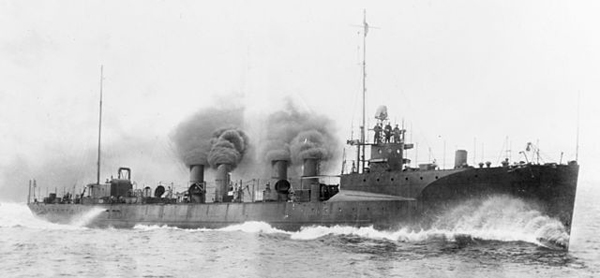
USS Flusser, Smith Class
These large first American ocean-going destroyers were part of a plan to dispense with light cruisers within the fleet. Therefore these units had to play the role of scout, had to be well armed and fast to flank and screen the fleet from far away stations. They were nicknamed the “thousand tonners” and opposed to the skinny Bainbridge of the years 1902. However, their armament was limited, especially in the matter of torpedoes still launched by single tubes. It was remedied in 1916 by replacing these with twin mounts without refills. The class included the USS Smith, Lamson, Preston, Flusser and Reid. They served in the Atlantic, based in Brest, and were stricken in 1919, because of the limitations of the Washington Treaty.
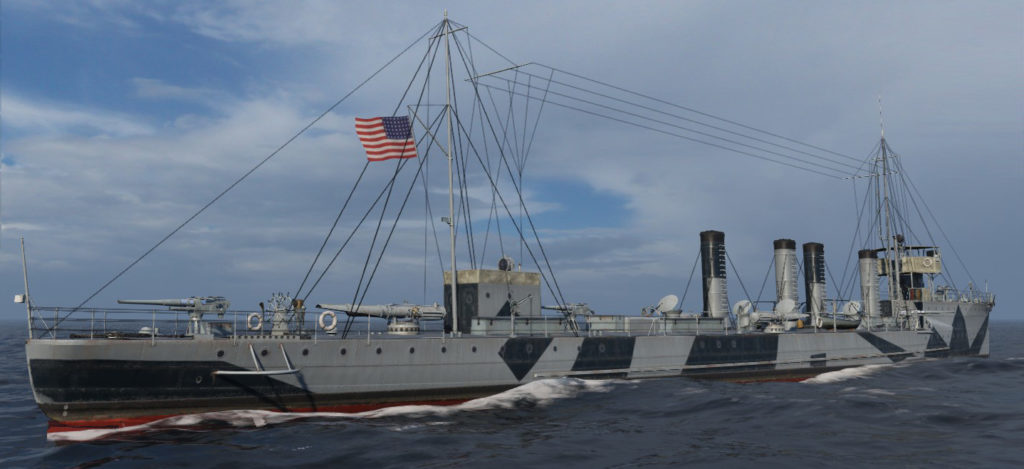

Author’s illustration of the USS Smith
Specifications
Displacement: 700t-900t FL
Dimensions: 90 x 8 x 2.4m
Propulsion: 4 Mosher boilers, 3 Parsons turbines, 10,000 hp. and 28 knots.
Crew: 73
Armament: 5 x 3in (76 mm) guns, 3 TTs 457 mm.
Paulding class DD22-DD43 (1909-1911)

USS Paulding camouflaged in Ireland, off Queensland, circa 1918
These destroyers later nicknamed the “flivvers” derived from the Bainbridge class differed only in their low front deck in “turtle backs”. With the Truxton class of 1901, larger, these five units participated actively in the Great War and will be withdrawn from service and sold in 1920. The Pauldings were considered as a 21-ship class, comprising also the Monaghan class (DD32-DD42, 1911), and sometimes the Roe class, and Drayton class.
The Paulding were improved Smith, with the torpedo tubes increased from three to six by using twin mounts, although still of the 18 in model (457 mm) and yet the twin mounts still weighed less than the older single mounts. They were armed the same with five 3-inch (76 mm)/50 caliber guns, a more homogeneous artillery than the 400 tonners. They were larger than the Smith at 742 long tons normal displacement up to 887 long tons fully loaded. To power them, they adopted the same arrangement of three Parsons direct-drive steam turbines mated to four oil-fired Normand boilers (other boilers were also used depending of the yards).
The model were notable for their particularly large heating area (tube surface area) in relation to the grate area but were also more complex to manufacture due to the fact the tubes were bent into many different and complex shapes, all unique. This gave them 12,000 shp (8,900 kW) as designed, 2,000 ihp more than the Smith. This gave them a top speed of 29.5 knots (54.6 km/h; 33.9 mph) as designed, while thery carried 245 tons of oil, for a 3,000 nmi (5,600 km; 3,500 mi) range at 16 knots (30 km/h; 18 mph). Not yet “thousand tonners” they were transitional ships. During the war they received one or two depth charge racks for the convoy escort. They all served in the interwar and were sold and broken up in 1934.

Author’s illustration of the Paulding class
Specifications
Displacement: 408t
Dimensions: 75.8 x 7.47 x 1.83m
Propulsion: 4 Thornycroft boilers, 2 propellers, 7200 hp. and 29 knots
Crew: 73
Armament: 2 x 3in (76mm), 5 x 2in (57mm), 2 TTs of 457mm.
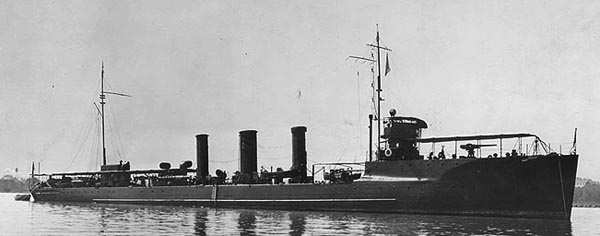
USS Monaghan DD-32 on trials
Cassin class DD43-DD50 (1912)
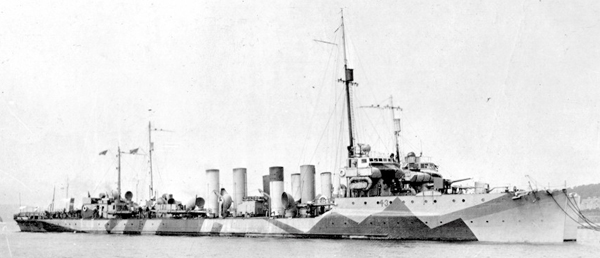
USS Cassin circa 1918, camouflaged, off Queensland, Ireland.
The Cassin were the first true “1000 tonners” as they saw an increase in normal displacement to over 1,000 tons. This was a request to combine a heavy armament more cruising range. They effectively were a reinforcement for the only three modern scout cruisers of the Chester class in service back then. Therefore destroyers had to be used as scouts. There arrangement of two-shaft direct drive turbines was similar to the earlier serie, but the poor performance of the cruising turbines led to a return to reciprocating engines for cruising. two of the ships even had triple expansion engines that could be clutched to one shaft for cruising.
Also armament-wise, these ships had 4-inch (102 mm)/50 caliber Mark 9 guns, which remained standard US destroyer main guns up to the Clemson-class destroyers, the mast of which were commissioned by 1921. These could raise and depress between -15° to +20° and traverse up to -150° to 150° and their rate of fire was 8-9 rounds per minute. Also the choice of four twin mounts, eight 18-inch (457 mm) torpedo tubes was an increase of two tubes over the Pauldings, the result of the General Board’s decision to have broadside mounts rather than axial ones, partly due to weight concerns and rarely torpedoes from axal mounts striking the gunwales. This overall reflected serious concerns about foreign equivalents. During the war, depth charge racks were also added.
In fact this class can be considered like the starter of the whole “thousand tonners” that also comprised four Cassins, four Aylwins, six O’Briens, six Tuckers, and six Sampsons, all roughly based on the same blueprints and seen below separately for they integrated some changes over time.

Author’s illustration of the Cassinc class
Specifications
Displacement: 1,020 tons (normal), 1,139 tons (full load)
Dimensions: 93.04 x 9.25 x 2.82 m (305 x 30 x 9 ft )
Propulsion: 4 Normand boilers, 2 direct-drive Parsons steam turbines, 16,000 shp
Speed: 29 knots (54 km/h; 33 mph), 312 tons oil (fuel)
Crew: 5 officers, 93 enlisted
Armament: 4 x 4 in (102 mm)/50, 4 x twin 18 inch (450 mm) TTs
Wartime American destroyers
The Naval Appropriation Act of 1916 was the founder act of a navy “second to none”, able to protect American coast and interests globally in the Atlantic and Pacific oceans.
There is a clear distinction to make here, linked to events: Before the United States were at war, we see the last Thousand Tonners entering service, of the O’Brien and Tucker classes, simple evolutions of the Paulding, but with this time 21 inch (533 mm) torpedo tubes banks in two twin banks for each broadside, a significant improvement as the new torpedoes were much more capable both in range and explosive power: The Mk.8 Mod 4 for example carried a 466 lb (211 kg) TNT payload over 16,000 yd (15,000 m) at 36 kn (67 km/h).
The larger Tucker were the result of compromises between the General Board of the US Navy and the Bureau of Construction and Repair. The Sampson eventually were still pushed forward by the General Board that wanted their scout, and the larger of the five classes with 1,225 tons (fully loaded). But the next serie, the Caldwell, were a brand new start, the result of the 1916 act calling for a true wartime scale-up production, and came at the same time with simplifications in design but also better performances and armament.
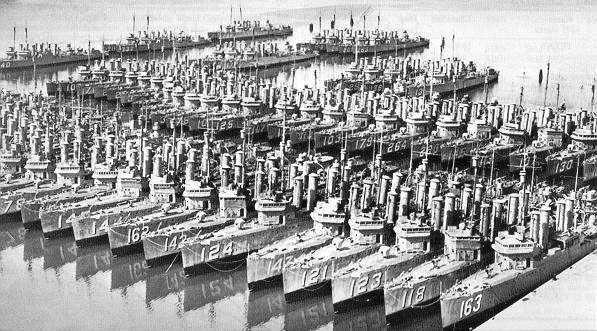
Mothballed DDs – Hazegray archives
O’Brien class DD51-DD56 (1914)
Their design resulted from dscuission of the general board with the bureau of ships and were as a result an incremental development of the Aylwin class, and displaced about a third more than the Paulding class, considered as the standard Thousand Tonners.
The O’Brien class were caracterisze overall by the choice of 21 inches (533 mm) torpedo tubes, a clea advantage compared to ter destroyers of the time. They displaced 1,050 long tons (1,070 t) for 305 feet (93 m) long by 31 feet (9.4 m) so a 1/10 ratio.
Their speed was helped by two direct-drive steam turbines and geared ones for 15 knots cruising. Their four 4-inch (102 mm) guns took place on the decks fore and aft, the two others being placed right at the end of the forward structure on each side, firing through recesses in the hull like all the other ships of the class. The four twin 21 inch (533 mm) TTs were on the sides. In wartime, they obtained depth charges.
Launched between between April 1914 and February 1915 they operated in the Atlantic or Caribbean April 1917. from then on, all six joined the Irish station at Queenstown for convoy escort. They rescued passengers and crew from sunken ships and had encounters with U-boats: USS Nicholson helped sink U-58 (November 1917), the first german submarine sunk by the U.S. Navy.
All were decommissioned by June 1922 but two joined the United States Coast Guard to enforce Prohibition (“Rum Patrol”) and returned to naval service in 1932 and 1933, but by june 1936 all had been broken up.
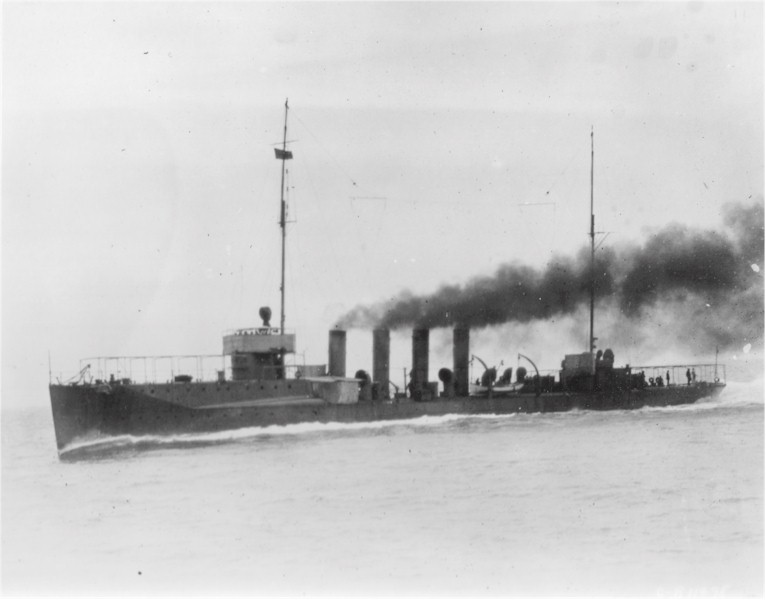
USS O’Brien, DD-51 in 1914
Tucker class DD57-DD62 (1915)
The six ships of the sub-class Tuckers were incrementally a bit heavier, at 1150 long tons of displacement standard and up to 1125 fully loaded, for about 29.5 knots, again with a combination for some of a single geared turbine and two direct drive ones for a 20 knots cruising speed.
Their thornycroft boilers developed a total of 17,000 shp (13,000 kW) to 17.500 on some ships for 2500 nautical miles in range. The armament was identical to the previous O’brien.
However before tey were drawn, the Bureau of Construction and Repair (C&R) own plans had to take in account a General Board asked request for six twin 21-inch (533 mm) TTs and twenty floating mines in addition to 35 knots (65 km/h) with 2,500 nautical miles raduis at the cruising speed of 20 knots.
C&R design was a 385-foot (117 m) long, 2,160-long-ton (2,190 t) three screw super-destroyer with 40,000 shaft horsepower (30,000 kW). It was in effect larger than the British design that inspired it, the HMS Swift of 1907. In the end only the cruising speed and range were met by the more reasonable design.
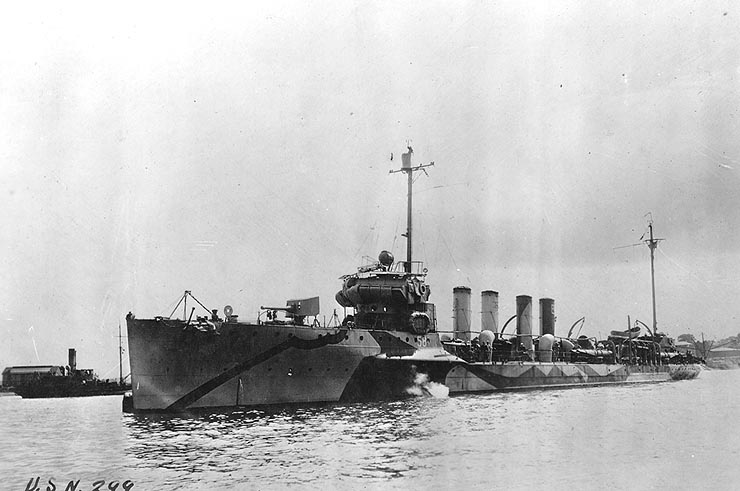
USS Conyngham, DD-58 in 1918
Sampson class DD63-DD68 (1916)
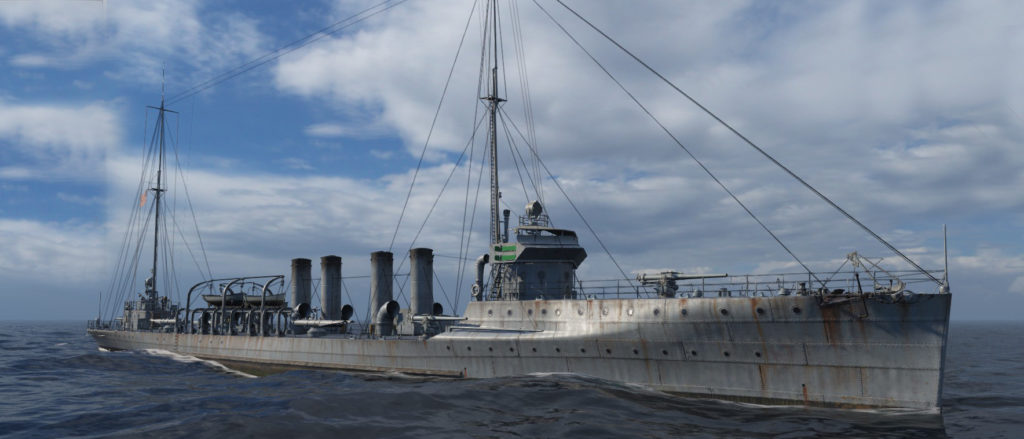
The last of the “thousand tonners” came with a larger displacement than any previous ship, and were powered by four Yarrow boilers mated to Curtis steam turbines and two shafts for 17,696 hp (13,196 kW) total and a top speed of 29.5 kn (54.6 km/h; 33.9 mph).
The armament was all new, outside the usual four 4 in (102 mm)/50 caliber guns, by the addition of two 1-pounder (37 mm) AA guns revealing the new aviation threat and four triple banks of 21 in (533 mm) torpedo tubes, also a considerably better armament for fleet escort, each ship being able to deliver a broadside of six torpedoes at once, in addition using the excellent Mark 8 torpedoes.
Also these ships were armed quite rapidly with depth charges in a single stern rack, and a Y-gun, or depth charge projector. The propulsion reflected the previous arrangement by using turbines in direct drive, and geared cruising turbines as in the preceding Tucker class. All these ships participated actively in the war, either on the eastern or western sectors of the Atlantic and were retired in the 1930s.
Caldwell class DD69-DD74 (1917)
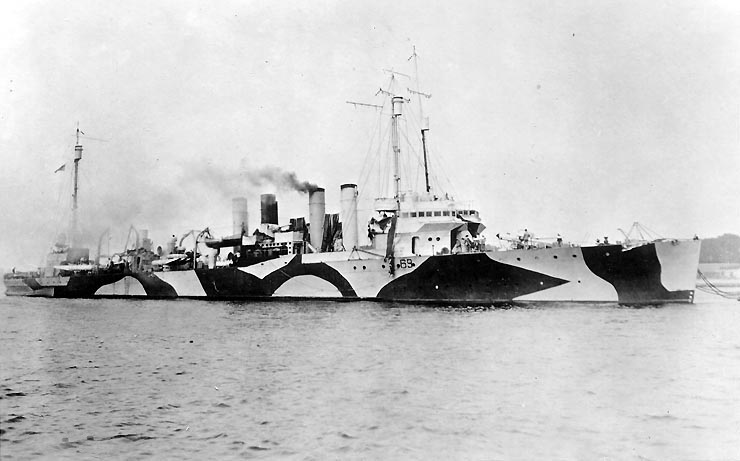
USS caldwell, DD-69
The General Board arguments for a 35 knots-capable destroyers with the C&R eventually led to some support in higher spheres as the six Caldwell-class were authorized by Congress under the Act of 3 March 1915, “to have a speed of not less than thirty knots per hour and to cost, exclusive of armor and armament, not to exceed $925,000.00 each…
Provided, that three of said torpedo-boats herein authorized shall be built on the Pacific Coast.” That was a bold move as traditional yards chosen produced ships for the Atlantic and therefore were Eastern yards. In fact the plans were so altered to met the specifications that the class was a radical departure over the “thousand tonners” and in fact were the blueprint of the Flush-deckers, some 280 wartime ships.
Their trademark flush-decked design was to remove the forecastle break weakness as well as a simplification in design. They were transitional ships, slower (30–32 knots (56–59 km/h) than the 35 knots (65 km/h)) following Wickes/Clemson class and differered by some details like their funnels (three for the Gwin, Conner and Stockton, the middle one being thicker as truncating two).
The hull design was improved to keep “A” mount from being constantly washed out and their cutaway stern allowed a tighter turning radius than the following classes. The Sampson armament was kept but the two side 4-inch (102 mm) guns were elevated on “bandstands” aft of the bridge.
They all served actively in WW1 for escort duties, and were partly mothballed during the interwar. But as part of these fast new generation destroyers they were still operable in 1939. In fact the USS Manley was converted to a high-speed destroyer transport (APD) that year, tested to carry 200 Marines and four 11 m (36 ft) Higgins assault boats (LCP(L) or later on alternative crafts like the LCP(R) and LCVP) and saw heavy action in the Pacific while other ships were sent as lend-Sease to the Royal Navy in 1940.
Specifications
Displacement: 1,020 tons (standard), 1,125 tons (normal)
Dimensions: 315 x 31 x 8 ft (96.16 x9.53 x2.4/3.51 m)
Propulsion: 4 Thornycroft boilers, 2 Parsons geared steam turbines (20,000 shp (15 MW) or White-Forster boilers with three Parsons direct drive turbines (18,500 hp (13.8 MW))
Speed: 32 kn (59 km/h) to 30 kn (56 km/h) (DD 72-73)
Complement: 146
Armament: 4 × 4 in (102 mm)/50, single 3 in (76 mm)/23 AA, 12 (4×3) × 21 in (533 mm)TTs
Wickes class DD75-DD185 (1918)

Wickes class, USS fairfax, author’s HD illustration
This class directly derived from the previous Caldwell to save time were entrusted to a wide variety of yards, and were built with proven systems (a bit like the Liberty Ships of WW2) and design simplifications all over the place.
111 were built in all, at Bath Iron Works, Fore River, Union Iron Works, Cramp, Newport News, SB New York, Cheapeake Naval Yard, Mare Island Arsenal, launched in November 1917 (USS Little) or June 1918 for the first completed (USS Wickes) and July 1919 for the last ones.
As a result, few were ready before the end of hostilities. They were more powerful than the Caldwell, capable of 35 knots (Just what the General Board wanted for years) and kept a formidable armament, with four 102 mm and four triple torpedo banks.
The previous Caldwell class experimented in 1917 with the principle of “flush-deck” hulls, but the Wickes were the best and most spectacular demonstration of industrial ingenuity when the aim was mass production, the flush deck hull allowed to simplify construction and reduce delays but also to solve some rigidity problems. In fact apart the additional raw power, no innovation was present on these ships which design was entirely dictated to facilitate mass production and allow fast training for the crews.
They will be especially the heart of the navy during the interwar period. If the majority was scrapped in 1936, a good part was still active in 1939. 50 be delivered to the British Navy (through Lease-lease), and three to the Royal Canadian Navy. The first 50 ships had been approved by the 1916 plan, and the others followed the fiscal years 1917 and 1918, with no less than fifteen being launched and completed in 1919.
Their tonnage increased from 90-100 tons to house the machinery capable of giving them the planned top speed of 35 knots, to act with the future scout cruisers of the class Omaha and the battle cruisers of the Lexington class. They differed in terms of fuel consumption and range, from about 2400 nautical miles to 20 knots, and had a port cruise turbine (Parsons, Bethlehem, Curtis or Westinghouse)and White-Forster, Normand or Yarrow boilers. Although easy to maintain and roomy they were strongly criticized for their limited seakeeping in heavy weather, waves hitting the bow and wetting the deck enough to render the front gun inoperative.
The many Wickes were followed by the Clemson class, which solved the problem of low autonomy, but not their seakeeping in heavy weather. The Wickes were used extensively in convoy escort, hunting German submarines until the end of the war. They formed the spearhead of the American Light Fleet. In 1929, all the ships equipped with Yarrow boilers were scrapped, but there were still a large number of them in 1941, so even after the 50 transferred to Great Britain, many were transformed into tankers, minelayers, transports, long-range escorts, actively participating in the Second World War on all fronts.
Specifications
Displacement: 1090t, 1247t FL
Dimensions: 94.5 x 9.4 x 2.8m (314 x30 x9 ft)
Propulsion: 4 boilers, 300 psi (2,100 kPa) saturated steam, 2 propellers, Parsons turbines, 24,200 hp. 35 knots max.
Crew: 114
Armament: 4 x 4in/50 (102mm) guns, 1 × 3 in/23 (76 mm) AA, 12 TTs (4×3) 21 in (533m)
Clemson class DD186-DD347 (1918)
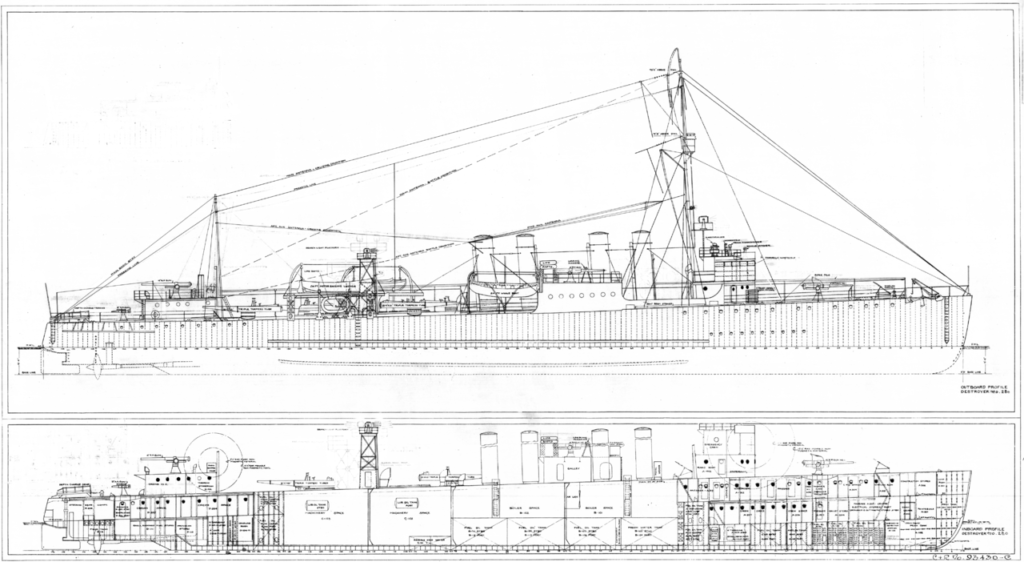
Blueprint of the Clemson class
Heavier by 100 tons with a higher draft to accommodate more coal, Westinghouse turbines, engineering focused on this new serie on improving the autonomy and radius, with a gain of 35% (2500 nautical miles). The single dual purpose 3in (76 mm) artillery piece was moved away from the front deck, too sensitive to spray in heavy weather, to a rear superstructure with a better shooting range.
For the rest, these ships were almost identical. 162 were started before the capitulation, for 156 completed and the others canceled. The two classes together totaled in 1921 (last completed) a total of 268 destroyers of the same type, a never seen production for any industrial ship so far. Launched in 1919-21, none of these Clemson series of destroyers will be ready on time to take part in the Great War, but they will have a long career in the US Navy.
Many were also scrapped in the 1930s, which for some represented a service life of barely ten years. In addition to the construction yards mentioned above, Squantum and Norfolk NyD also joined the effort to produce these destroyers. The lessons they bring were precious from 1942 when it was again question of mass-producing such classes of ships, but on a much larger scale and more models altogether about a quarter of century after. An entire post will be dedicated to the WW2 service and transformations of these ships in the future.
Specifications
Displacement: 1190t, 1308t FL
Dimensions: 94.5 x 9.4 x 3m
Propulsion: 4 boilers, 2 propellers and Westinghouse turbines, 27,000 hp. and 35 knots max.
Crew: 114
Armament: 4 x 102mm guns, 12 TLT (4×3) 533mm, 2x 1pdr AA (40mm), 1x 76mm.

Help Naval Encyclopedia !
Get the USS Fairfax (Wickes class Poster)

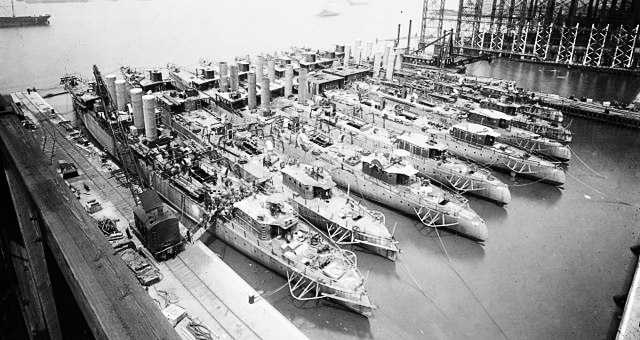
Destroyers at Camden Shipyard, 1919
Links/Src
Infographics HD Evolution of US Destroyers up to Zumwalt
American WW1 DDs on wikipedia
Wickes class DDs (Wikipedia)
Flush deckers ion Hazegray
The flush-deckers on Destroyerhistory.org
Video – 1966 “American DDs, greyhounds of the seas” US Navy archives footage, narrated by Jack Webb
Original Source (Fr)
-Conway’s all the world fighting ships 1860-1905 and 1906-1921.
Blair, Clay, Silent Victory (Vol.1), The Naval Institute Press, 2001
Lanning, Michael Lee (Lt. Col.), Senseless Secrets: The Failures of U.S. Military Intelligence from George Washington to the Present, Carol Publishing Group, 1995
Preston, Anthony, The World’s Greatest Submarines”, Greenwich Editions, 2005.
On destroyerhistory.org
destroyers.org – Clemson class – The Tin clad sailors
history.navy.mil about DDs torpedoes
navweaps.com weapons 4in /50mk9
destroyerhistory.org – wickes class

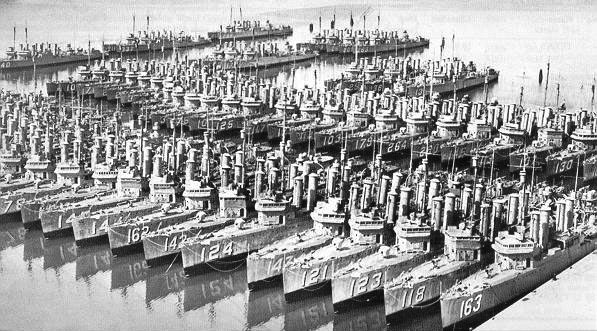

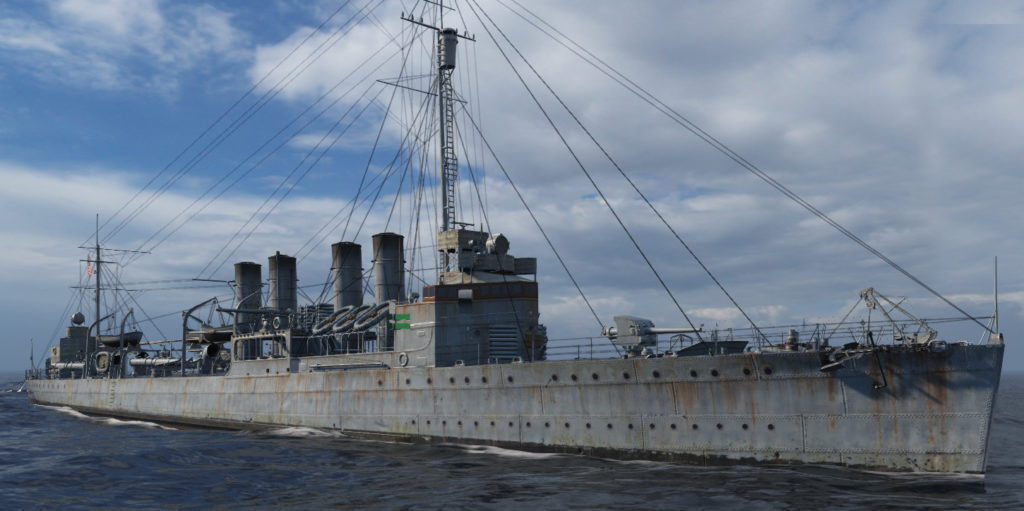
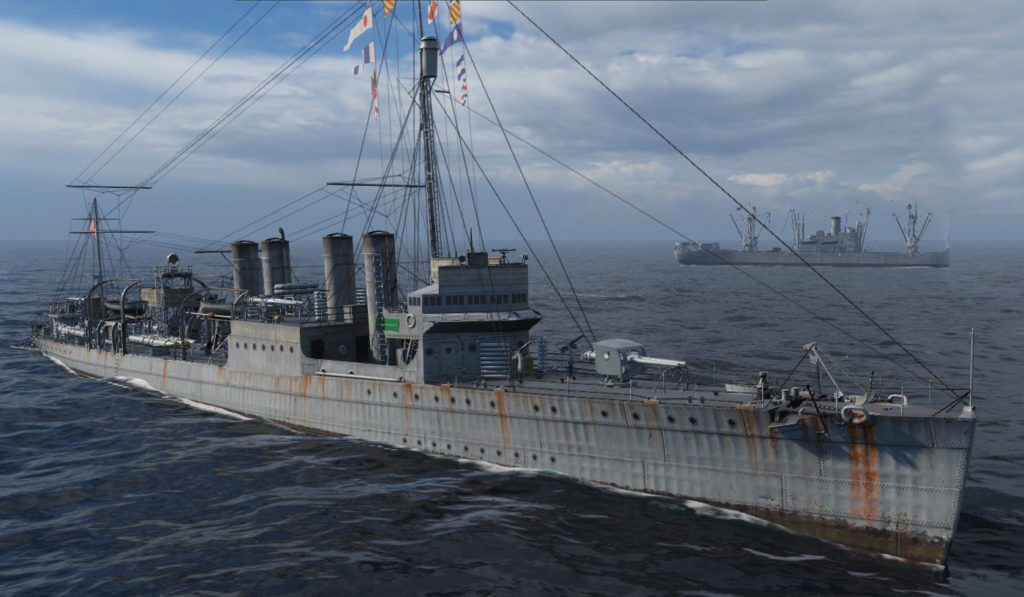
 Latest Facebook Entry -
Latest Facebook Entry -  X(Tweeter) Naval Encyclopedia's deck archive
X(Tweeter) Naval Encyclopedia's deck archive Instagram (@navalencyc)
Instagram (@navalencyc)





 French Navy
French Navy Royal Navy
Royal Navy Russian Navy
Russian Navy Armada Espanola
Armada Espanola Austrian Navy
Austrian Navy K.u.K. Kriegsmarine
K.u.K. Kriegsmarine Dansk Marine
Dansk Marine Nautiko Hellenon
Nautiko Hellenon Koninklije Marine 1870
Koninklije Marine 1870 Marinha do Brasil
Marinha do Brasil Osmanlı Donanması
Osmanlı Donanması Marina Do Peru
Marina Do Peru Marinha do Portugal
Marinha do Portugal Regia Marina 1870
Regia Marina 1870 Nihhon Kaigun 1870
Nihhon Kaigun 1870 Preußische Marine 1870
Preußische Marine 1870 Russkiy Flot 1870
Russkiy Flot 1870 Svenska marinen
Svenska marinen Søværnet
Søværnet Union Navy
Union Navy Confederate Navy
Confederate Navy Armada de Argentina
Armada de Argentina Imperial Chinese Navy
Imperial Chinese Navy Marinha do Portugal
Marinha do Portugal Mexico
Mexico Kaiserliche Marine
Kaiserliche Marine 1898 US Navy
1898 US Navy Sovietskiy Flot
Sovietskiy Flot Royal Canadian Navy
Royal Canadian Navy Royal Australian Navy
Royal Australian Navy RNZN Fleet
RNZN Fleet Chinese Navy 1937
Chinese Navy 1937 Kriegsmarine
Kriegsmarine Chilean Navy
Chilean Navy Danish Navy
Danish Navy Finnish Navy
Finnish Navy Hellenic Navy
Hellenic Navy Polish Navy
Polish Navy Romanian Navy
Romanian Navy Turkish Navy
Turkish Navy Royal Yugoslav Navy
Royal Yugoslav Navy Royal Thai Navy
Royal Thai Navy Minor Navies
Minor Navies Albania
Albania Austria
Austria Belgium
Belgium Columbia
Columbia Costa Rica
Costa Rica Cuba
Cuba Czechoslovakia
Czechoslovakia Dominican Republic
Dominican Republic Haiti
Haiti Hungary
Hungary Honduras
Honduras Estonia
Estonia Iceland
Iceland Eire
Eire Equador
Equador Iran
Iran Iraq
Iraq Latvia
Latvia Liberia
Liberia Lithuania
Lithuania Mandchukuo
Mandchukuo Morocco
Morocco Nicaragua
Nicaragua Persia
Persia San Salvador
San Salvador Sarawak
Sarawak Uruguay
Uruguay Venezuela
Venezuela Zanzibar
Zanzibar Warsaw Pact Navies
Warsaw Pact Navies Bulgaria
Bulgaria Hungary
Hungary

 Bundesmarine
Bundesmarine Dutch Navy
Dutch Navy Hellenic Navy
Hellenic Navy Marina Militare
Marina Militare Yugoslav Navy
Yugoslav Navy Chinese Navy
Chinese Navy Indian Navy
Indian Navy Indonesian Navy
Indonesian Navy JMSDF
JMSDF North Korean Navy
North Korean Navy Pakistani Navy
Pakistani Navy Philippines Navy
Philippines Navy ROKN
ROKN Rep. of Singapore Navy
Rep. of Singapore Navy Taiwanese Navy
Taiwanese Navy IDF Navy
IDF Navy Saudi Navy
Saudi Navy Royal New Zealand Navy
Royal New Zealand Navy Egyptian Navy
Egyptian Navy South African Navy
South African Navy






























 Ukrainian Navy
Ukrainian Navy dbodesign
dbodesign
DD 438